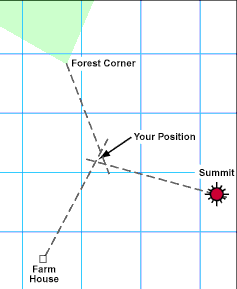Back Bearing - when not on a line feature

Using Back Bearings to identify your position when not on a Line Feature (Resection).
This is the same as the method described in Back Bearing - when on a line feature except that you need to take bearings on at least two (and preferably three) identifiable points lying in different arcs of the compass.
Your position will lie where the two (or three) back bearings intersect (or within the triangle created at the intersection).
Strictly speaking the bearing from the identifiable feature to your position will be the bearing from your position plus 180 degrees. i.e. If you take a bearing on a summit and the compass says its 60 degrees, then the bearing from the summit to your position will be 60 + 180 = 240 degrees. However, since the compass will line up on your position anyway, without adding anything, you can ignore this finery.
Also note that a compass only goes up to 360 degrees, so sometimes adding 180 will give you a result higher than 360 degrees – e.g. a Target which has a bearing of 240 degrees, will give a result of 420 degrees if you add 180.
To use a Back Bearing to identify your position when on a line feature see Back Bearing - when on a line feature




















